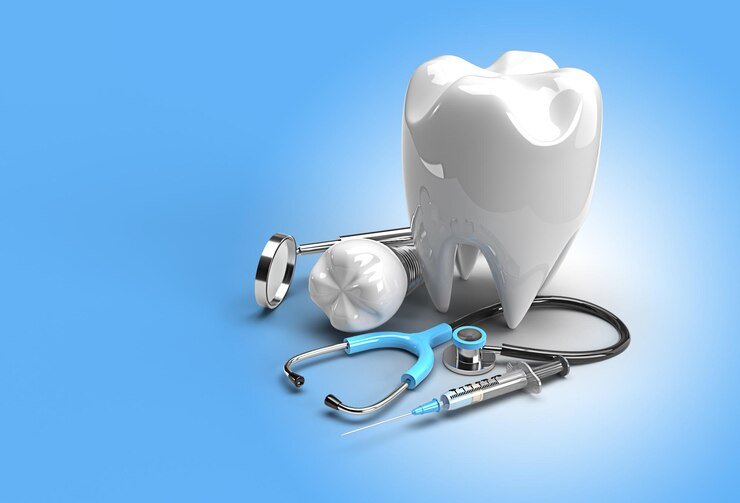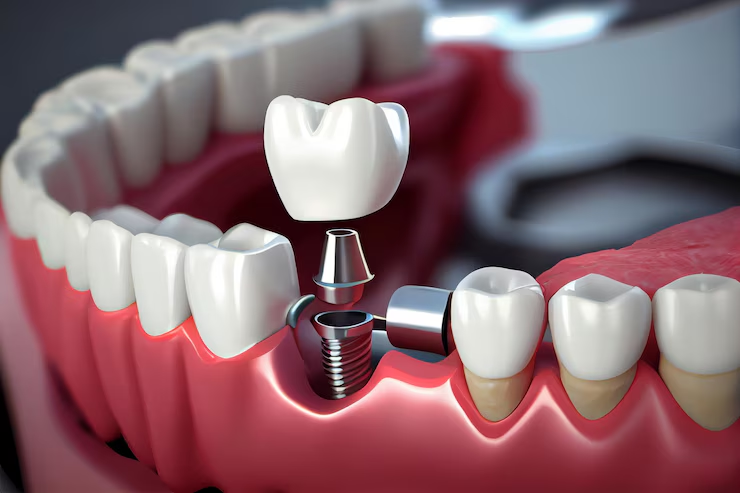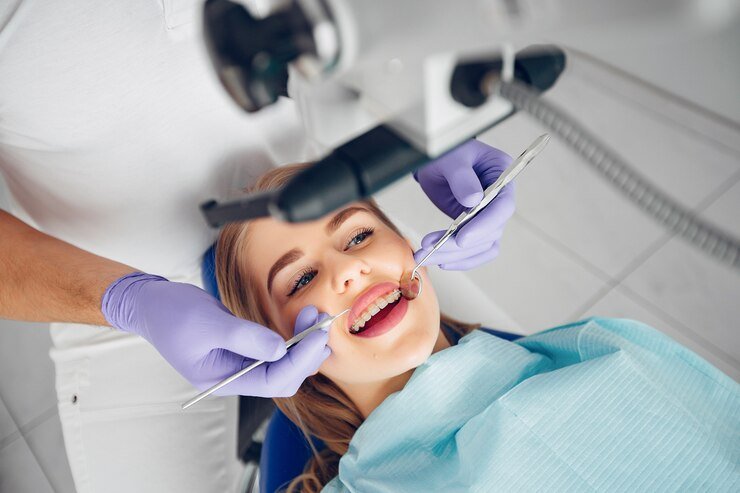Dental
Dental Specialty & its Branches

Dental Specialty and its Branches
Dentistry stands as a pivotal branch within the medical field, honing its focus on diagnosing, preventing, and treating ailments afflicting the oral cavity and its adjoining structures. Within this domain, dental professionals, comprising dentists and dental hygienists, wield significant influence in safeguarding oral well-being and thwarting dental maladies. Among the procedures performed, routine cleanings, cavity fillings, root canals, and tooth extractions rank as commonplace interventions. Furthermore, dentistry extends its purview to encompass cosmetic enhancements, such as teeth whitening, veneers, and dental implants, to elevate aesthetic appeal.
Dental experts recognize the connection between oral and overall health and adeptly detect signs of systemic diseases during routine examinations. Emphasis on education and preventive strategies underscores the drive to instill robust oral hygiene practices and forestall dental issues across all age groups. Collaboration with allied healthcare providers ensures a holistic approach to care, especially for patients navigating complex medical conditions. The evolution of dental technology and techniques fosters enhanced treatment outcomes and heightened patient contentment.
Despite strides in innovation, global challenges persist in ensuring equitable access to dental care, prompting concerted efforts to address disparities and bolster oral health inclusivity. In summation, dentistry emerges as a cornerstone in augmenting quality of life, preserving oral health integrity, and restoring both function and aesthetics to the dental landscape.



Dental Specialty and Its Branches
Despite strides in innovation, global challenges persist in ensuring equitable access to dental care, prompting concerted efforts to address disparities and bolster oral health inclusivity. In summation, dentistry emerges as a cornerstone in augmenting quality of life, preserving oral health integrity, and restoring both function and aesthetics to the dental landscape.


Detailed Components
Endodontics
Diagnosis and treatment of diseases and injuries of the dental pulp and periapical tissues. Standard Procedures: Root canal therapy, endodontic retreatment, surgery (apicoectomy), and treating dental trauma.
Oral and Maxillofacial Surgery
Focus: Surgical correction of disorders, traumas, and deformities affecting the jaws, head, neck, and oral and maxillofacial region's hard and soft tissues. Standard Procedures: Tooth extractions, corrective jaw surgery, cleft lip and palate surgery, facial trauma repair, dental implants, TMJ surgery
Orthodontics and Dentofacial Orthopedics
Focus: Diagnosis, prevention, interception, and correction of malocclusion (improper bites) and other abnormalities of the developing or mature orofacial structures. Standard Procedures: Braces, clear aligners (Invisalign), retainers, orthognathic surgery planning.
Pediatric Dentistry
Focus: Oral health treatment for young children, adolescents, and those with special needs. Standard Procedures: Preventive care (cleanings, fluoride treatments), restorative procedures (fillings, crowns), management of dental trauma, treatment under sedation or general anesthesia.
Periodontics
Focus: Diagnosis, treatment, and prevention of disorders affecting the tissues that surround and support teeth (gums) and their alternates. Gum grafts, dental implants, periodontal surgery, and scaling and root planning (deep cleaning) are common procedures
Prosthodontics
Focus: Replacing teeth and other oral structures through prostheses and restorations. Standard Procedures: Crowns, bridges, dentures, dental implants, full mouth reconstruction, maxillofacial prosthetics
Oral and Maxillofacial Radiology
Focus: The creation and interpretation of radiographic data and pictures for the purpose of managing and diagnosing problems, illnesses, and diseases pertaining to the oral and maxillofacial area.
Oral and Maxillofacial Pathology
Focus The study, diagnosis, and sometimes treatment of diseases affecting the oral and maxillofacial regions. Standard Procedures: Biopsies, histopathologic analysis, management of oral diseases, research



Public Health Dentistry
Focus: Promoting oral health and preventing dental diseases on a community-wide basis.
Common Procedures include community dental health programs, fluoride and sealant programs, oral health education, and policy development
Dental Anesthesiology
Focus: Managing pain, anxiety, and overall patient health during dental, oral, and maxillofacial procedures.
Standard Procedures: Sedation, general anesthesia, and pain management techniques


Importance of Dental Specialties
-
Comprehensive Care
Dental specialties ensure comprehensive and specialized care for complex dental and oral health issues
-
Advanced Training
Specialists receive additional training and education to manage specific conditions that general dentists may not be equipped to handle
-
Collaboration
Specialists often work in partnership with general dentists and other healthcare providers to offer integrated and multidisciplinary care
-
Improved Outcomes
Specialized care often leads to improved patient outcomes, particularly for complex and severe conditions
-
Innovations
Dental specialists are often involved in research and innovation, contributing to advancements in dental technology and treatment methodologies.


12 Specialties of Dental Doctor
Focus: Diagnosis and treatment of diseases and injuries of the dental pulp and periapical tissues.
Standard Procedures: Root canal therapy, endodontic retreatment, apicoectomy, and management of dental trauma
Focus: surgical correction of conditions affecting the head, neck, face, jaws, and the oral and maxillofacial region's hard and soft tissues.
Common Procedures: Tooth extractions, corrective jaw surgery, cleft lip and palate surgery, facial trauma repair, and dental implants.
Focus: Malocclusion (incorrect bites) and other anomalies of the growing or mature orofacial structures are diagnosed, prevented, and corrected.
Standard Procedures: Braces, clear aligners (Invisalign), retainers, and orthognathic surgery planning.
Focus:oral health treatment for young children, adolescents, and those with special needs.
Standard Procedures: Preventive care (cleanings, fluoride treatments), restorative procedures (fillings, crowns), management of dental trauma, and treatment under sedation or general anesthesia.
Focus: Diagnosis, treatment, and prevention of disorders affecting the tissues that surround and support teeth (gums) and their replacements.
Standard Procedures: Scaling and root planning (deep cleaning), periodontal surgery, dental implants, and gum grafts.
Focus: Restoration and replacement of teeth and other oral structures through prostheses and restorations.
Standard Procedures: Crowns, bridges, dentures, dental implants, full mouth reconstruction, and maxillofacial prosthetics.
Focus: The creation and interpretation of radiographic data and pictures for the purposes of managing and diagnosing problems, illnesses, and diseases pertaining to the oral and maxillofacial area.
Standard Procedures: Interpreting X-rays, CT scans, MRIs, and other imaging modalities.
Focus The study, diagnosis, and sometimes treatment of diseases affecting the oral and maxillofacial regions.
Standard Procedures: Biopsies, histopathologic analysis, management of oral diseases, and research.
Focus: Promoting oral health and preventing dental diseases on a community-wide basis.
Common Procedures: Community dental health programs, fluoride and sealant programs, oral health education, and policy development
Focus: Managing pain, anxiety, and overall patient health during dental, oral, and maxillofacial procedures.
Standard Procedures: Sedation, general anesthesia, and pain management techniques.
Focus: Diagnosis and management of medically related conditions affecting the oral and maxillofacial region.
Standard Procedures: Management of oral mucosal diseases, salivary gland disorders, and orofacial pain.
Focus: Management of chronic pain disorders of the jaw, mouth, face, and associated structures.
Standard Procedures: Treatment of temporomandibular disorders (TMD), neuropathic facial pain, and other complex pain conditions.
These dental specialties ensure comprehensive and specialized care for various oral health issues, promoting better patient outcomes and advancements in dental practices
0120: Periodic oral evaluation - established patient:
This code is used for routine oral examinations for established patients. It entails a thorough examination of the patient's oral health, including a status check on oral hygiene and an assessment of the teeth, gums, and soft tissues.
This code is utilized when a specific oral health issue or concern needs to be addressed. It involves a focused examination of the area of concern, such as a toothache or gum inflammation, rather than a comprehensive assessment of overall oral health.
Preventive Services
This code is for professional dental cleaning procedures performed on adult patients to remove plaque, tartar, and stains from the teeth. It helps prevent tooth & gum decay and gum disease by maintaining oral hygiene
Applying fluoride varnish is a preventative step that helps to fortify tooth enamel and stave off dental disease. It involves applying a fluoride-based solution to the teeth to promote remineralization and reduce the risk of cavities
Restorative Procedures
This code is used for the placement of dental fillings using amalgam material (silver fillings) on a single surface of a primary or permanent tooth. It is typically employed for treating tiny cavities.
Resin-based composite restorations involve the use of tooth-colored filling material to repair teeth affected by decay or damage. This code applies to extensive restorations involving four or more surfaces on posterior teeth (molars or premolars).
Endodontic Treatments
This code covers root canal therapy performed on anterior teeth (front teeth) to treat infection or inflammation of the dental pulpit entails removing diseased or damaged dental tissue and closing the root canal to stop the infection from spreading.
An apicoectomy is a surgical technique used to remove the diseased tissue surrounding the tip of a tooth's root. It is usually recommended when retreatment is not practical or when a root canal treatment is unable to eradicate infection.
Dental Implants
A titanium implant is the surgically inserted into the jawbone during dental implant placement to function as a stand-in tooth root. This code applies specifically to the surgical placement of the implant body (the portion embedded in the bone) for endosteal implants
Temporomandibular joint arthrocentesis is a minimally invasive procedure used to treat TMJ disorders. It involves injecting medication into the TM
At iMedbillingPro, we are aware of the challenges and suffering that healthcare providers encounter when delivering first-rate patient care.
Copyright © 2024 iMed Billing Pro All Rights Reserved.

